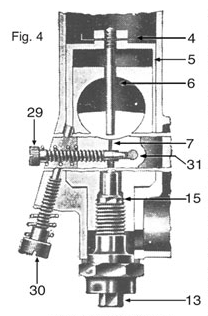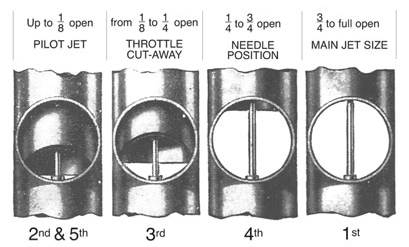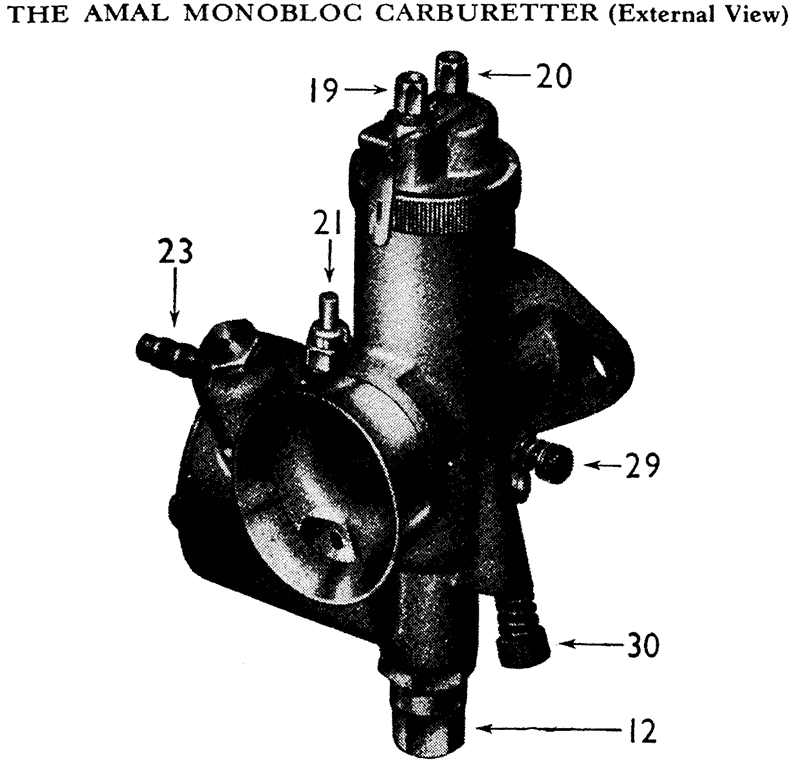Petrol Feed (verification).
Later models are fitted with a filter gauze at the inlet to the float chamber. To remove the filter gauze unscrew the banjo bolt (22), the banjo can then be removed and the filter gauze withdrawn from the needle seating. Ensure that the filter gauze is undamaged and free from all foreign matter. Before replacing banjo turn on petrol tap momentarily and see that fuel gushes out.
* On Monobloc types there are bleed holes in the needle jet which serve the double purpose of air compensating the mixture from the needle jet and allowing the fuel to provide a well outside and around the jet which is available for snap acceleration.
Flooding may be due to a worn needle or a leaky float, but nearly all flooding with new machines is due to impurities (grit, fluff, etc.) in the tank —so clean out the float chamber periodically till the trouble ceases. If the trouble persists, the tank might be drained, swilled out, etc.
 FIG. 27 & FIG. 28 Section Through Mixing Chamber (Air Valve and Throttle Closed) and Float Chamber
FIG. 27 & FIG. 28 Section Through Mixing Chamber (Air Valve and Throttle Closed) and Float Chamber
Re-assembling (after dismantling)
See that the washer on the bottom of the jet block is in good condition otherwise fuel will leak across its face causing rich erratic running if the washer is faulty it should be replaced by a new one. When replacing the throttle see that the jet needle goes into the centre hole in the jet block and once in, note the throttle works freely when the mixing chamber cap (2) is screwed clown firmly and held by spring (18).
When re-assembling the float see that the narrow leg ortion of its hinge is uppermost, as this operates the needle. Care should be taken to see that the joint faces of the side cover and body are not damaged or bruised andthat the joint washer is in good condition, otherwise difficulty will be experienced in making a petrol tight joint.
Cable Controls.
See that there is a minimum of backlash when the controls are set back and that any movement of the handlebar does not cause the throttle to open. The adjusters are on the top of the carburetter. See that the throttle shuts down freely.
Adjustment
 |
(a) This figure is three diagramatic sections of the carburetter to show the throttle adjusting screws (30) and the pilot air adjusting screw (29) (b) Throttle Adjusting Screw (30) Set this screw to hold the throttle open sufficiently to keep the engine running when the twist grip is shut off. (c) Pilot Air Adjusting Screw (29) This screw regulates the strength of the mixture for idling and for the initial opening of the throttle. The screw controls the depression on the pilot jet by metering the amount of air that mixes with the petrol (d) Main Jet (15) The main jet controls the petrol supply when the throttle is more than three-quarters open, but at smaller throttle openings although the supply of fuel goes through the main jet, the amount is diminished by the metering effect of the needle in the needle jet. Each jet is calibrated and numbered so that its exact discharge is known and two jets of the same number are alike. Never reamer a jet out, get another of the right size. The bigger the number the bigger the jet. To remove the main jet unscrew the main jet cover, the exposed main jet can then be unscrewed from the jet holder. (e) Needle and Needle Jet. The needle is attached to the throttle valve and being taper - either allows more or less petrol to pass through the needle jet as the throttle is opened or closed throughout the range, except when idling or nearly full throttle. The taper needle position in relation to the throttle opening can be set according to the mixture required by fixing it to the throttle valve with the jet needle clip in a certain groove (see Fig. 4- above), thus either raising or lowering it. Raising the needle richens the mixture and lowering it weakens the mixture at throttle openings from quarter to three-quarters open (see Fig. 29 below). The needles are marked with the letters B, C, or D. B types are fitted in the 375 Carburetter, C type in the 376 Carburetter, and D type in the 389 Carburetter. The needles in some cases are marked with a number in addition to a letter. (f) Throttle Valve Cut-away. The atmospheric side of the throttle is cut away to influence the depression on the main fuel supply and thus gives a means of tuning between the pilot and needle jet range of throttle opening. The amount of cut-away is recorded by a number marked on the throttle valve, viz., 376/3 means throttle valve type 376 with No. 3 cut-away ; larger cut-aways, say 4 and 5 give weaker mixtures and 2 a richer mixture.
(g) Air Valve is used only for starting and running when cold, and for experimenting with, otherwise run with it wide open. (h) Tickler. A small plunger spring loaded, in the float chamber wall. When pressed down on the float, the needle valve is allowed to open and so "flooding“ is achieved. Flooding temporarily enriches the mixture until the level of the petrol subsides to normal. |

Adjust in the following order.
Note. The carburetter is automatic throughout the throttle range - the air valve should always be wide open except when used for starting or until the engine has warmed up. We assume normal petrols are used.
Read remarks on pages 63 and 66 for each tuning device and get the motor going perfectly on a quiet road with a slight up gradient so that on test the engine is pulling.
1st Main Jet with throttle in position 1 (Fig. 29).
If at full throttle the engine runs “heavily" the main jet is too large.
If at full throttle by slightly closing the throttle or air valve the engine seems to have better power, the main jet is too small.
With a correct sized main jet the engine at full throttle should run evenly and regularly with maximum power.
If testing for speed work ensure that the main jet size is sufficient for the mixture to be rich enough to keep the engine cool, and to verify this examine the sparking plug after taking a fast run, de-clutching and stopping the engine quickly. If the plug body at its end has a cool appearance the mixture is correct : if sooty. the mixture is rich : if however there are signs of intense heat, the mixture is too weak and a larger main jet is necessary.
2nd. Pilot ]et (Fig. 5). with throttle in positions 2 and 5.
With engine idling too fast with the twist grip shut off and the throttle shut down on to the throttle adjusting screw, and ignition set for best slow running: (1) Screw out throttle adjusting screw until the engine runs slower and begins to falter, then screw pilot air adjusting screw in or out, to make engine run regularly and faster. (2) Now gently lower the throttle adjusting screw until the engine runs slower and just begins to falter, adjust the pilot air adjusting screw to get best slow running; if this 2nd adjustment makes engine run too fast, go over the job again a third time.
3rd. Throttle Cut-away with throttle in position 3 (Fig. 5).
If, as you take off from the idling position, there is objectionable spitting from the carburetter, slightly richen the pilot mixture by screwing in the air screw sufficiently, but if this is not effective, screw it back again, and fit a throttle with a smaller cut-away. If the engine jerks under load at this throttle position and there is no spitting, either the jet needle is much too high or a larger throttle cut-away is required to cure richness.
4th. Needle with throttle in postion 4 (Fig. 5).
The needle controls a wide range of throttle opening and also the acceleration. Try the needle in as low a position as possible, viz., with the clip in a groove as near the top as possible; if acceleration is poor and with air valve partially closed the results are better, raise the needle by two grooves; if very much better try lowering needle by one groove and leave it where it is best. If mixture is still too rich with clip in groove No. 1 nearest the top—the needle jet probably wants replacement because of wear. If the needle itself has had several years’ use replace it also.
5th. Finally go over the idling again for final touches.
Do not adjust the carburetter to get a very slow tick over, since such a setting will involve the throttle valve having to be opened much further to start from cold, and the consequent reduction of the depression on the pilot system will weaken the mixture and starting will become difficult.
In cases where difficulty is encountered set the throttle stop screw to give a reasonably fast idling speed by screwing the adjuster a little further in. Set the pilot air-bleed screw to give a slightly rich mixture by also screwing it inwards (clockwise) a trifle
Tracing Faults.
There are only two possible faults in carburation, either richness or weakness of mixture.
Indications of :
|
Richness |
Weakness |
|
Black smoke in exhaust. |
Spitting back in carburetter. |
|
Petrol spraying out of carburetter. |
Erratic slow running. |
|
Four strokes, eight-stroking. |
Overheating. |
|
Two strokes, four-stroking. |
Acceleration poor. |
|
Heavy, lumpy running |
Engine goes better if :- · Throttle is not wide open or · Air Valve is partially closed. |
|
Sparking plug sooty |
|
If richness or weakness is present, check if caused by:
| (1) Petrol feed. |
Check that jets and passages are clear, that filter gauze in float chamber banjo connection is not choked with foreign matter, and that there is ample flow of fuel. Check there is no flooding. |
| (2) Air leaks. | At the connection to the engine or due to leaky inlet valve stems |
| (3) Defective or worn parts. | As a loose fitting throttle valve, worn needle jet, loose jets. |
| (4) Air cleaner being choked up. | |
| (5) An air cleaner having been removed |
Removing the silencer or running with a straight through pipe requires a richer setting.
Having verified the correctness of fuel feed and that there are no air leaks, check over ignition, valve operation and timing. Now at throttle position shown on page 66, fig. 29, test to see if mixtures are rich or weak. This is done by partially closing the air valve, and if engine runs better weakness is indicated, but if engine runs worse richness is indicated.
To remedy, proceed as follows :
|
|
To cure richness. |
To cure weakness. |
|
Position 1. |
Fit smaller main jet. |
Fit larger main jet. |
|
Position 2. |
Screw out pilot air adjusting screw. |
Screw pilot air adjusting screw in. |
|
Position 3. |
Fit a throttle with larger cutaway (para. F, page 66). |
Fit a throttle with smaller cutaway (para. F, page 66). |
|
Position 4. |
Lower needle one or two grooves (para. E, page 66). |
Raise needle one or two grooves (para. E, page 66). |
Fixing Carburetter.
Erratic slow running is often caused by air leaks, so verify there are none at the point of attachment to the cylinder or inlet pipe—-check by means of an oilcan and eliminate by new washers and the equal tightening up of the flange nuts. On later models a sealing ring is fitted into the attachment flange of the carburetter. Also in old machines look out for air leaks caused by a worn throttle or worn inlet valve guides.
Banging in Exhaust may be caused by too weak a pilot mixture when the throttle is closed or nearly closed—-also it may be caused by too rich a pilot mixture and an air leak in the exhaust system; the reason in either case is that the mixture has not fired in the cylinder and has fired in the hot silencer. If the banging happens when the throttle is fairly wide open open the trouble will be ignition - not carburation.
Bad Petrol Consumption of a new machine may be due to flooding, caused by impurities from the petrol tank lodging on the float needle seat and so prevent its valve from closing. Flooding may be caused by a worn float needle valve. Also bad petrol consumption will be apparent if the needle jet (15) (see Fig. 27) has worn; it may be remedied or improved by lowering the needle in the throttle, but if it cannot be—then the only remedy is to get a new needle jet.
Air Filters.
These may affect the jet setting, so if one is fitted afterwards to the calrburetter the main jet may have to be smaller. If a carburetter is set with an air filter and the engine is run without it, take care not to overheat the engine due to too weak a mixture; testing with air valve (page 66), will indicate if a larger main jet and higher needle position are required.
Effect of Altitude on Carburetter.
Increased altitude tends to produce a rich mixture. The greater the altitude, the smaller the main jet required. Carburetters ex-works are set suitable for altitudes up to 3,000 feet approximately. Carburetters used constantly at altitudes 3,000 to 6,000 feet should have a reduction in main jet size of 5 per cent, and thereafter for every 3,000 feet in excess of 6,000 feet altitude further reductions of 4 per cent should be made.


